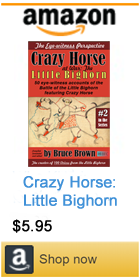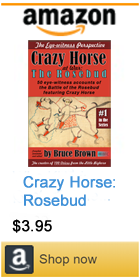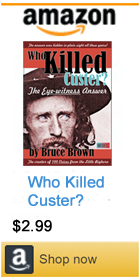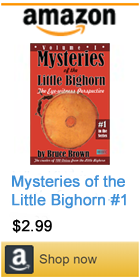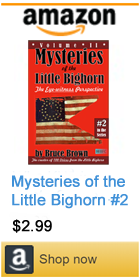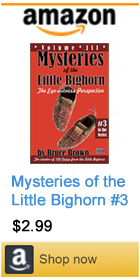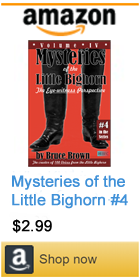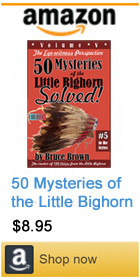|
||||||||||||
Bruce Brown's 100 Voices... Water Man's Story of the Battle
Sometimes when an Indian slept he would keep his best horse at the door of his tepee, holding in his hand the rope to which the horse was tied. It was considered a very brave deed for an Indian to slip into an enemy camp at night and cut the rope of a horse outside a tepee, and ride him away. I had lived twenty-two snows at the time of the great battle on the Little Bighorn River. That was a long time ago, but my mind is clear, and I will tell you all I know about that battle. There were five of us Arapahoes in that fight. Three have joined the spirits of their fathers, and now only Left Hand and I, Waterman, still live. Soon we too must go to the long sleep, and no one will be alive to tell the story, so I will tell you, whom the Arapahoes call their Soldier-Chief, everything just as I saw it, and nothing that is not the truth. The Arapahoes were camped at Fort Robinson where they drew their rations from the government, and I, with four other young bucks, slipped out of the agency to go on a scouting party for Shoshones. With me were Yellow Eagle, Yellow Fly, Well-Knowing One [Sage] and Left Hand. We rode north into the buffalo country, and one day near the Little Bighorn River we met a small party of Sioux. They told us that the Sioux were going to have a sun-dance, and said that we should come along with them to the Sioux village and have a good time. Afterward I learned that these Sioux thought we were scouts for the white soldiers. We rode along with them, and as we came near the village a great many Sioux came out of the camp to meet us. They took all our guns away, and made us prisoners, saying that we were scouts of the white man, and that they were going to kill us. That night we were guarded so we could not escape, and in the morning, Two Moon, Chief of the Cheyenne, learned we were Arapahoes, so he went to the Sioux Chiefs and made them give us back our guns and set us free. The Cheyennes and the Arapahoes have always been brothers. The Sioux gave us our guns, but they kept a close watch on us, so we could not get away. We remained in the Sioux camp and saw the sun rise twice. Then the whole village moved farther down the river and made another camp. It was the biggest camp I ever saw. There were thousands of warriors. I do not know how many. When the sun came up again, that was the day of the fight. We heard shooting at the upper end of the village, and we all went that way. The soldiers had crossed the river and were coming toward the camp. At that time the sun was there (position indicating about 9:00 A. M.). There were not many soldiers, and I knew they would be beaten because there were many Sioux and Cheyennes. There was one Indian killed there. The soldiers went back across the river to a ridge where they dug some pits. The Indians kept shooting at them for a long time. After a while we heard shooting at the lower end of the village, and, knowing it must be another body of soldiers, we started down there as fast as we could. These troops were trying to cross the river and attack the camp, but the Indians drove them back. The soldiers could have forded the river at that point, because we crossed over and drove them up the hill. When they got to the top of the hill, they left their horses and the Indians took them. Some of the horses got away and came down to the river where they were caught by some of the Indians. There were grey horses and some sorrels. This left the soldiers on foot completely surrounded by the Indians. The soldiers were on the high ground, and in one of the first charges we made a Cheyenne Chief named White Man Cripple [AKA Lame White Man] was killed. Two Moon then took command of the Cheyennes and led them all during the fight. During the earlier part of the fight, I was with some Indians in a small gulch below the hill where the soldiers were, but later we moved up the hill and closed in on the soldiers. There was a great deal of noise and confusion. The air was heavy with powder smoke, and the Indians were all yelling. Crazy Horse, the Sioux Chief, was the bravest man I ever saw. He rode closest to the soldiers, yelling to his warriors. All the soldiers were shooting at him, but he was never hit. The Indians on horseback had shields and rode on the sides of their horses so the soldiers could not hit them. The soldiers were entirely surrounded, and the whole country was alive with Indians. There were thousands of them. A few soldiers tried to get away and reach the river, but they were all killed. A few did get down to the river, but were killed by some Indians there. The Indians were running all around shooting and yelling, and we were all very excited. I only know of one soldier that I killed. It was just at the last of the fight when we rushed to the top of the hill and finished all that were still alive. I killed him with my gun, but did not scalp him because the Arapahoes do not scalp a man with short hair, only long hair. When I reached the top of the hill I saw Custer. He was dressed in buckskin, coat and pants, and was on his hands and knees. He had been shot through the side and there was blood coming from his mouth. He seemed to be watching the Indians moving around him. Four soldiers were sitting up around him, but they were all badly wounded. All the other soldiers were down. Then the Indians closed in around him, and I did not see any more. Most of the dead soldiers had been killed by arrows, as they had arrows sticking in them. The next time I saw Custer he was dead, and some Indians were taking his buckskin clothes. The Indians were quarreling, each trying to take the clothes away from the other. I do not know who got them. The fight was all over when the sun was there (position indicating about three o'clock). The squaws then crossed the river and began taking the clothes off the dead soldiers. Sometimes one that was not yet dead would move a little, and the squaws would become frightened and scatter. What the squaws did to the dead soldiers I do not know, because I did not go back to see. I saw many soldiers who were scalped, but do not know whether Custer was scalped or not, because I went back across the river to camp after the fight was over. During the battle I was dressed in beaded leggings, breech-clout, a white shirt and a large war-bonnet. My face was painted yellow and red, and around my neck, tied in a deer-skin medicine bag, was a certain root, which was my medicine. I still have that same medicine. The Sioux kept a close watch on us, because during the fight Left Hand had killed a Sioux warrior, whom he thought was one of Custer's Crow or Arikara scouts, and the Sioux were very angry. [Note: here's Left Hand's account of accidently killing the Sioux warrior.] The white people believe that there were a great many Indians killed in this fight. I only know of six Cheyennes and six Sioux who were killed. There were many wounded. That night we stayed in the Sioux camp, but the next night, after it was dark, Yellow Eagle, Yellow Fly, Well-Knowing One [Sage], Left Hand and I crawled out under the side of our wickiup, mounted ponies, slipped out of camp and rode on around the foot of the mountains back to Fort Robinson. That was many moons ago, and since then great changes have come upon us. The buffalo are all gone, and the Indians who once roamed these plains and were happy, are now held on reservations as wards of the government. My people are very poor, and sometimes have not enough to eat. Of the five Arapahoes who were in the battle of the Little Bighorn, only Left Hand and I, Waterman, are now alive. We are old men now, and soon we too must pass over to the great mystery. That is why I have told you this story. The Custer Myth: A Source Book of Custerania, written and compiled by Colonel W.A. Graham, The Stackpole Co., Harrisburg, PA 1953, p 109 - 111
Waterman was one of five Arapahoes who fought with the Sioux and Cheyenne at the Battle of the Little Bighorn. Here are eye-witness accounts of the battle from two other Arapahoes -- Sage and Left Hand -- plus Cheyenne war chief Young Two Moon's account of how they came to be there.
|
||||||||||||



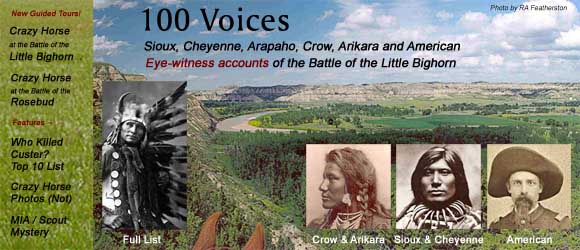
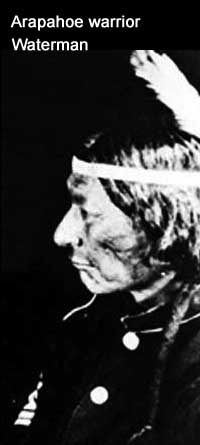 A LONG time ago -- when I was a young man, it was the custom of the young Indian to go on small war parties looking for Shoshones or other unfriendly tribes. If our medicine was good, we sometimes returned to camp with a scalp or a number of ponies.
A LONG time ago -- when I was a young man, it was the custom of the young Indian to go on small war parties looking for Shoshones or other unfriendly tribes. If our medicine was good, we sometimes returned to camp with a scalp or a number of ponies.
